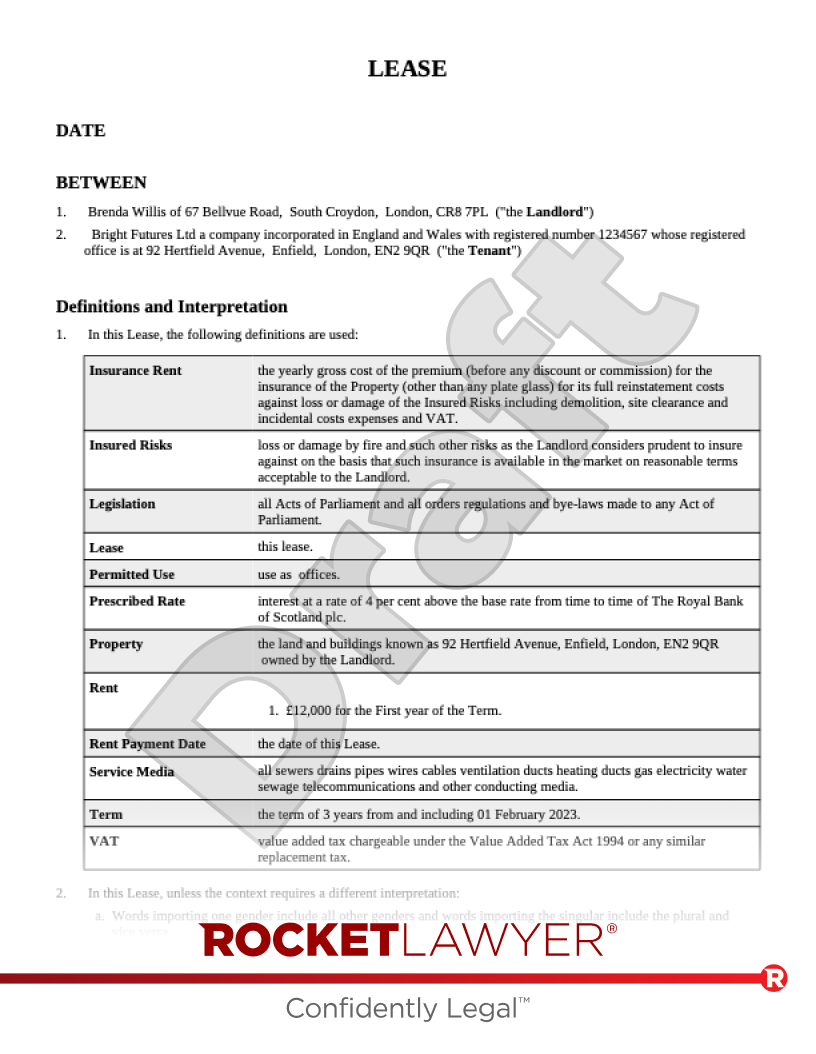What are commercial lease heads of terms?
Commercial lease heads of terms are simple documents that reflect the main terms of a deal reached between a landlord and a tenant. They essentially formalise what has been agreed between the commercial landlord and the tenant. As such, commercial lease heads of terms form the basis of the Commercial lease the landlord and tenant will enter into.
Commercial lease heads of terms are usually prepared by the landlord and are specific to each lease and property.
Setting out terms from the outset in this way means that the landlord can plan the rental income they will receive, know when they will get the property back, and inform the tenant(s) of what is expected from them. Making commercial lease heads of terms before entering into a commercial lease helps the landlord and tenant save money and time. It also helps prevent any misunderstandings about what the lease will contain.
Are commercial lease heads of terms legally binding?
Unlike the final commercial lease, commercial lease heads of terms are generally not legally binding. Commercial lease heads of terms are designed to be used to set out the main terms of the commercial lease without being legally binding.
Commercial lease heads of terms will be ‘subject to contract’ and this should be expressly stated on the document. This means that the terms in the commercial lease heads of terms aren’t legally binding. Any terms set out in the commercial lease heads of terms will generally only be binding once they form part of a formal commercial lease signed by both the commercial landlord and tenant.
Key terms for commercial lease heads of terms
Commercial landlords should consider a number of key terms when forming heads of terms, and should negotiate these with the tenant. These key terms include:
-
tenant details - the landlord will want to obtain references and financial information about the tenant to make sure that they are satisfied that the tenant can pay the rent during the term
-
property - the full details of the commercial property should be included along with any additional rights the landlord will grant the tenant (eg the right to park a car or access to a cycle store)
-
rent - commercial leases are usually granted at ‘market rent’ for an annual sum paid monthly or quarterly in advance. Rent can be paid on completion (ie execution) of the lease, or the landlord may decide that the tenant can have a rent-free period so rent payments will start on a future date
-
term - how long the lease will run for needs to be agreed. Depending on the length of the term, other clauses, such as a break clause, may be relevant. A short-term lease usually runs for between 1 and 3 years
-
assignment and underletting - depending on the length of the term, the landlord may allow the tenant to assign or underlet the whole of the property. An assignment allows the tenant to pass on the lease to another, while an underlease allows another to use the property, but the tenant is still responsible for the property under their headlease. For more information, read Assigning a business lease and Subletting business premises
-
permitted use - the use of the property must be recorded so that the tenant knows what the permitted use of the property is
-
break clause - the landlord needs to decide whether they, the tenant or both of them will be able to end the lease early by giving notice to the other. If there will be a break clause the date and any pre-conditions should be included. For more information, read Break clause notices
-
security of tenure - short-term leases are usually excluded from the statutory right to a new lease when the current lease ends. In Scotland, there is no statutory provision that provides the tenant with an automatic right to stay beyond the lease end date, with the exception of the Tenancy of Shops (Scotland) Act 1949. If notice of termination is not given by either landlord or tenant at the end of the lease, the lease will continue under the same terms on a yearly basis (this is known as ‘tacit relocation’) until valid notice is provided. For more information, read Security of tenure
-
rent deposit - if the landlord is concerned about whether the tenant will be able to pay the rent, the landlord could request that they provide a rent deposit as security. If so, the amount to be paid should be recorded in the heads of terms
-
short-term lets licence - as of October 2023, landlords in Scotland need to have a licence for each short-let property they manage before they can take reservations or host paying guests. This includes commercial property
Does it matter what is agreed in the commercial lease heads of terms?
Although not legally binding, commercial lease heads of terms show the intent of the commercial landlord and tenant but do not legally require them to go on and complete the lease. Either party can still change their mind and not enter into the Commercial lease, or negotiate further changes to terms before entering into the lease.
However, the commercial lease heads of terms form the basis for the subsequent commercial lease. As a result, the terms set out in the commercial lease heads of terms should reflect what the parties reasonably want their commercial lease to look like.
Ask a lawyer if you have any questions or concerns about commercial lease heads of terms.




